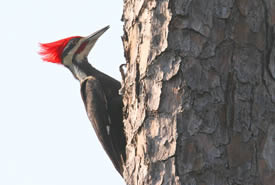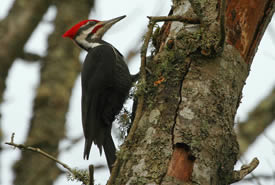Pileated Woodpecker

Pileated Woodpecker (Photo by Bill Hubick)
"The pileated woodpecker is a large and striking forest bird.
Unlike many other birds, male and female pileated woodpeckers have little colour variation between sexes. The male pileated woodpecker has a red facial stripe that extends out from the base of the bill, where as the female has a black stripe.
Where does this species live?
Pileated woodpeckers are cavity nesters that excavate their own nesting holes. The male begins the excavation and completes most of the work; the female joins the male once the cavity is close to completion.
It can take up to three weeks to excavate a nest site and the sites are rarely reused in subsequent years by the pileated woodpeckers.
Often, nest sites become homes for other cavity nesters.

Pileated woodpecker (Photo by Bill Hubick)
How to identify a pileated woodpecker cavity
Unlike other woodpeckers, the entrance hole to the pileated woodpecker nest is a more oval shape. They prefer large, mature trees and therefore, are more commonly found in mature woodlots but can be found in younger forests or urban areas with large trees.
What does this species eat?
Pileated woodpeckers dig holes in trees when searching for food. They primarily feed on carpenter ants and wood boring beetle larvae, termites, flies, caterpillars, cockroaches and other insects.
Pileated woodpeckers will also eat fruits and nuts and have been known to feed on seed and suet from backyard feeders.
What does this species sound like?
Pileated woodpeckers are very vocal birds. Click below to hear their call (courtesy of Bill Hubick.)
Supported by the Weston Family Foundation.





